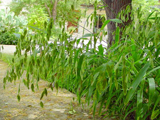Native Plants

Q. Who is Mr. Smarty Plants?
A: There are those who suspect Wildflower Center volunteers are the culpable and capable culprits. Yet, others think staff members play some, albeit small, role. You can torture us with your plant questions, but we will never reveal the Green Guru's secret identity.
Did you know you can access the Native Plant Information Network with your web-enabled smartphone?
Ask Mr. Smarty Plants is a free service provided by the staff and volunteers at the Lady Bird Johnson Wildflower Center.

rate this answer
Wednesday - January 30, 2013
From: Waco, TX
Region: Select Region
Topic: Pruning, Grasses or Grass-like
Title: Trimming inland sea oats from Waco TX
Answered by: Barbara Medford
QUESTION:
Re: Inland Sea Oats and trimming back in early spring "It passes through most of winter a soft brown, but becomes tattered and gray by February, a good time to cut it back to the basal rosette." This site includes this information. Where exactly is the "basal rosette?"ANSWER:
We could not find any pictures of the "rosette" of Chasmanthium latifolium (Inland sea oats). The first picture below is how they should look probably in April. The next picture is the tattered and gray condition mentioned in your quotation from our webpage on the plant condition in February. At that point, we would recommend going in and trimming back to about 6 inches above the soil. They will be brown spindly sticks but it will remind you where the plant is. They may already have some little grassy spikes sticking up at the point, coming up from the root, and will continue to grow until they look like the third picture below.
From the Image Gallery
More Pruning Questions
Trimming of dead foliage on trunks of yucca in California
December 21, 2008 - There is a Yucca plant in the back yard. I want to know how to get the old foliage that has died off of the trunks, it looks kind of ragged. The foliage is about three feet from the green. Can you ...
view the full question and answer
Controlling oak suckers in Austin
June 24, 2012 - We have 2 live oak trees that are sprouting shoots all around the surrounding area. We would like to plant some grass and would like to remedy this first.
We have mowed the shoots and still they jus...
view the full question and answer
How do I prepare blackfoot daisies for winter in Austin, TX
October 19, 2010 - I have blackfoot daisies in my garden that have bloomed all summer. They are cascading out of the bed onto my lawn/grass. They have been so beautiful that I hate to cut them back. How do I prepare t...
view the full question and answer
Non-native Podocarpus macrophyllus in Ft Worth TX
November 12, 2011 - I know this question does not pertain to a native plant but I've spent too much time not finding an answer to my question. I have many mature Podocarpus macrophyllus bushes at my house I purchased in...
view the full question and answer
Browning of leaf tops on Iris plants
April 22, 2008 - My Iris plants bloomed beautifully, now some of the leaves are turning brown from the top down, about half way. Is this normal? What can I do about it and should I cut off the brown leaves? Also, what...
view the full question and answer
| Support the Wildflower Center by Donating Online or Becoming a Member today. |

